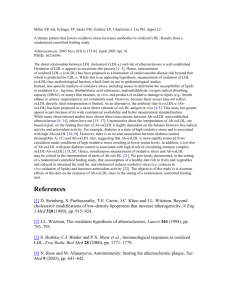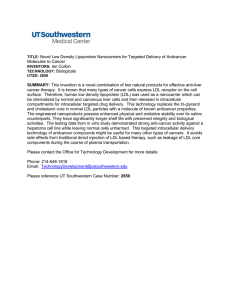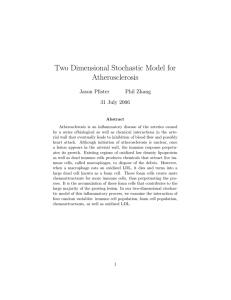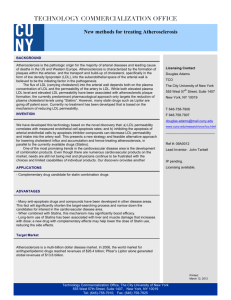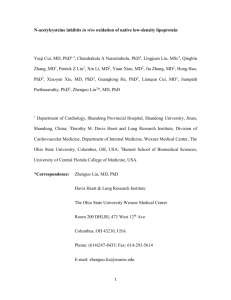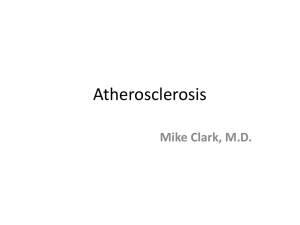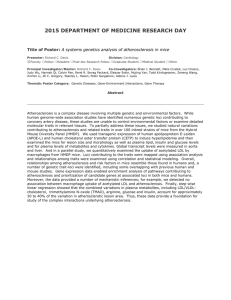Ethnic variation in levels of circulating IgG autoantibodies Michelle A. Miller
advertisement
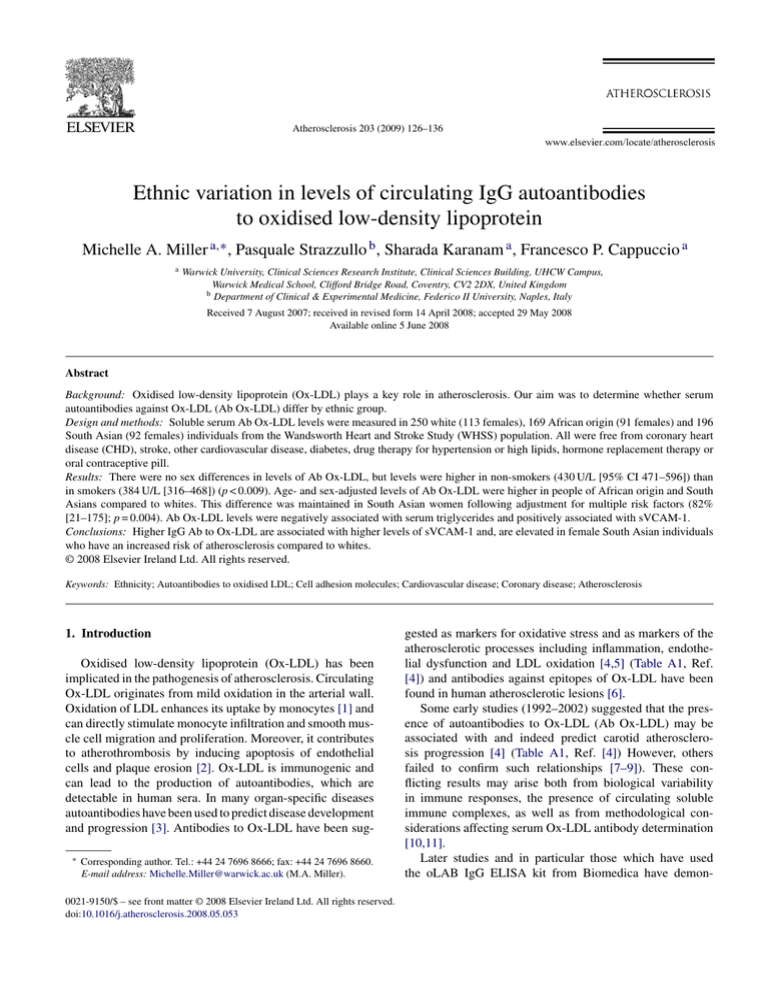
Atherosclerosis 203 (2009) 126–136 Ethnic variation in levels of circulating IgG autoantibodies to oxidised low-density lipoprotein Michelle A. Miller a,∗ , Pasquale Strazzullo b , Sharada Karanam a , Francesco P. Cappuccio a a Warwick University, Clinical Sciences Research Institute, Clinical Sciences Building, UHCW Campus, Warwick Medical School, Clifford Bridge Road, Coventry, CV2 2DX, United Kingdom b Department of Clinical & Experimental Medicine, Federico II University, Naples, Italy Received 7 August 2007; received in revised form 14 April 2008; accepted 29 May 2008 Available online 5 June 2008 Abstract Background: Oxidised low-density lipoprotein (Ox-LDL) plays a key role in atherosclerosis. Our aim was to determine whether serum autoantibodies against Ox-LDL (Ab Ox-LDL) differ by ethnic group. Design and methods: Soluble serum Ab Ox-LDL levels were measured in 250 white (113 females), 169 African origin (91 females) and 196 South Asian (92 females) individuals from the Wandsworth Heart and Stroke Study (WHSS) population. All were free from coronary heart disease (CHD), stroke, other cardiovascular disease, diabetes, drug therapy for hypertension or high lipids, hormone replacement therapy or oral contraceptive pill. Results: There were no sex differences in levels of Ab Ox-LDL, but levels were higher in non-smokers (430 U/L [95% CI 471–596]) than in smokers (384 U/L [316–468]) (p < 0.009). Age- and sex-adjusted levels of Ab Ox-LDL were higher in people of African origin and South Asians compared to whites. This difference was maintained in South Asian women following adjustment for multiple risk factors (82% [21–175]; p = 0.004). Ab Ox-LDL levels were negatively associated with serum triglycerides and positively associated with sVCAM-1. Conclusions: Higher IgG Ab to Ox-LDL are associated with higher levels of sVCAM-1 and, are elevated in female South Asian individuals who have an increased risk of atherosclerosis compared to whites. © 2008 Elsevier Ireland Ltd. All rights reserved. Keywords: Ethnicity; Autoantibodies to oxidised LDL; Cell adhesion molecules; Cardiovascular disease; Coronary disease; Atherosclerosis 1. Introduction Oxidised low-density lipoprotein (Ox-LDL) has been implicated in the pathogenesis of atherosclerosis. Circulating Ox-LDL originates from mild oxidation in the arterial wall. Oxidation of LDL enhances its uptake by monocytes [1] and can directly stimulate monocyte infiltration and smooth muscle cell migration and proliferation. Moreover, it contributes to atherothrombosis by inducing apoptosis of endothelial cells and plaque erosion [2]. Ox-LDL is immunogenic and can lead to the production of autoantibodies, which are detectable in human sera. In many organ-specific diseases autoantibodies have been used to predict disease development and progression [3]. Antibodies to Ox-LDL have been sug∗ Corresponding author. Tel.: +44 24 7696 8666; fax: +44 24 7696 8660. E-mail address: Michelle.Miller@warwick.ac.uk (M.A. Miller). 0021-9150/$ – see front matter © 2008 Elsevier Ireland Ltd. All rights reserved. doi:10.1016/j.atherosclerosis.2008.05.053 gested as markers for oxidative stress and as markers of the atherosclerotic processes including inflammation, endothelial dysfunction and LDL oxidation [4,5] (Table A1, Ref. [4]) and antibodies against epitopes of Ox-LDL have been found in human atherosclerotic lesions [6]. Some early studies (1992–2002) suggested that the presence of autoantibodies to Ox-LDL (Ab Ox-LDL) may be associated with and indeed predict carotid atherosclerosis progression [4] (Table A1, Ref. [4]) However, others failed to confirm such relationships [7–9]). These conflicting results may arise both from biological variability in immune responses, the presence of circulating soluble immune complexes, as well as from methodological considerations affecting serum Ox-LDL antibody determination [10,11]. Later studies and in particular those which have used the oLAB IgG ELISA kit from Biomedica have demon- M.A. Miller et al. / Atherosclerosis 203 (2009) 126–136 strated more uniform results [5,12–16] (Table A1, Ref. [5,12–16,37]). In particular, Ab Ox-LDL was associated with markers of inflammation and was an independent risk factor for adverse cardiac events [16]. However, studies performed at this time, using methods which determine IgM Ox-LDL autoantibodies, have suggested that higher levels of IgM Ab Ox-LDL may predict a favourable outcome (Table A1, Ref. [38]) and may have an inverse association with carotid atherosclerosis (Table A1, Ref. [39]). This dichotomy between different autoantibodies was confirmed in a recent study in which both IgG and IgM autoantibodies to Ox-LDL were determined in the same individuals. That study demonstrated that, whereas IgG autoantibodies were positively associated with coronary artery disease IgM were inversely associated [17]. However, in a study of healthy Japanese individuals it was observed that plasma Ox-LDL was inversely correlated with oLAB IgG Ab Ox-LDL [18]. Coronary heart disease (CHD) is more common amongst South Asians and is markedly reduced in blacks [20,21]. This holds true in the country of origin and when the individuals migrate to a new host country [19,20]. OxLDL can up-regulate the expression of adhesion molecules [21], either directly [22] or indirectly, by amplifying the release of cytokines [23]. We have shown that whilst, there are no detectable differences in adhesion molecule levels between South Asians and whites; healthy people of first generation black African origin, living in England, have significantly lower levels of sICAM-1, sVCAM-1 and sPselectin [24]. The purpose of this study was to investigate whether (a) Ab Ox-LDL are associated with CHD risk by using an essentially healthy population derived from three different ethnic groups as a model of differing CHD risk; (b) there are any associations with CHD risk factors; (c) any difference between ethnic groups may be explained by associations with cardiovascular and CHD risk factors. 2. Materials and methods 2.1. Subjects As described previously, ‘healthy’ individuals were selected from the Wandsworth Heart and Stroke Study (WHSS) population of whom 615 had samples suitable for analysis [24,25]. The subjects were not on hypertension or lipid lowering medication and not taking the oral contraceptive pill or hormone replacement therapy and they did not have any previous medical history of ischaemic heart disease, stroke or diabetes. Of the individuals studied, 250 were white (113 females), 169 were of African origin (91 females) and 196 were of South Asian origin (92 females). People of African origin were all first generation immigrants. The Local Ethics Committee approved the study. All participants gave their informed consent to participate. 127 2.2. Methods Subjects who had fasted overnight and had refrained from smoking or taking vigorous exercise were seen between 08:00 a.m. and 12:00 noon the following day. A detailed questionnaire was administered and height and weight were measured [25]. Blood pressure was taken with standard methods and an automated recorder [25]. Fasting blood was taken in the seated position without stasis [25]. 2.3. Biochemical measurements Serum Ox-LDL levels were determined by measuring IgG antibodies (Ab) to Ox-LDL using commercially available ELISA kits (oLAB; Biomedica). These kits use highly specific autoantibodies for Ox-LDL to preclude the possibility of cross-reactivity with other autoantibodies. Serum samples had been stored at −40 ◦ C and defrosted at room temperature prior to analysis. Medium and high quality control pools were included in each assay. The intra- and inter-assay coefficients of variation were <10%. Biochemical measurements were performed with standardised methods, as described previously [25]. 2.4. Framingham risk scores These were calculated using published equations for predicting the incident risk of CHD and combined cardiovascular disease risk from the Framingham study as previously described [26]. 2.5. Statistical analysis The distribution of serum Ab Ox-LDL levels was positively skewed; therefore analyses were performed on logtransformed data. Results are presented as geometric mean and 95% confidence intervals (CI). Differences between ethnic groups (adjusted for age and sex) were tested using analysis of co-variance. Caribbean and West Africans were compared separately to whites as a reference using multiple regression, adjusting for age and sex, smoking, measures of obesity, social class, serum lipids, blood pressure, serum insulin and plasma total homocysteine. Since the independent variables have been log-transformed prior to analysis the regression coefficients (β) and 95% CI were exponentiated and expressed as the percentage increase in Ab Ox-LDL in each ethnic group compared to whites. A p value of less than 0.05 was considered statistically significant. 3. Results 3.1. Population characteristics and levels of Ab Ox-LDL As previously described [24] and outlined in Table 1 there were marked ethnic differences in the cardiovas- 128 M.A. Miller et al. / Atherosclerosis 203 (2009) 126–136 Table 1 Age and sex adjusted characteristics of 615 men and women aged 40–59 years of different ethnic groups living in Wandsworth, South London, 1994–1996 White (n = 250) (kg/m2 ) Body mass index Waist:hip ratio Systolic blood pressure (mmHg) Diastolic blood pressure (mmHg) Total cholesterol (mmol/L) HDL cholesterol (mmol/L) Serum triglycerides (mmol/L)a Serum glucose (mmol/L) Serum insulin (mU/L)a Vitamin C Plasma homocysteine (mol/l)a sE-selectin (ng/mL)a sP-selectin (ng/mL)a sICAM-1 (ng/mL)a sVCAM-1 (ng/mL)a Ox-LDL antibodies (U/L)a 10-Year CHD risk (%) 10-Year CVD risk (%) 25.7 (25.2–26.2) 0.86 (0.85–0.86) 123.1 (120.1–125.2) 78.6 (77.3–79.8) 6.1 (6.0–6.3) 1.41 (1.37–1.45) 1.09 (1.03–1.15) 5.01 (4.94–5.08) 6.8 (6.3–7.3) 44.6 (41.4–47.7) 10.0 (9.6–10.3) 45.3 (43.0–47.7) 72 (69–75) 275 (264–287) 434 (421–448) 377 (330–432) 7.75 (7.18–8.32) 10.27 (9.53–11.02) African origin (n = 169) (26.6–27.9)†† 27.2 0.87 (0.86–0.88) 126.9 (124.2–129.6)† 83.2 (81.7–84.7)†† 5.5 (5.3–5.7)†† 1.49 (1.44–1.55)† 0.71 (0.71–0.82)†† 4.93 (4.85–5.01) 7.7 (7.1–8.5)† 41.8 (38.3–45.4) 9.5 (9.1–9.9) 45.9 (43.1–48.9) 58 (54–61)†† 187 (178–197)†† 388 (373–403)†† 526 (445–621)† 5.70 (5.01–6.4)†† 8.21 (7.29–9.12)† South Asian (n = 196) p 25.4 (24.9–26.1) 0.88 (0.87–0.89)## 125.7 (123.3–128.2) 81.3 (79.9–82.7)# 5.7 (5.5–5.9)## 1.21 (1.16–1.26)## 1.31 (1.25–1.42)## 5.05 (4.98–5.13) 10.3 (9.5–11.2)## 36.2 (32.8–39.7)# 11.4 (11.0–11.9)## 45.7 (43.1–48.5) 72 (69–76) 267 (255–281) 443 (428–460) 578 (495–675)## 8.12 (7.48–8.76) 10.46 (9.61–11.30) <0.001 <0.001 =0.670 <0.001 <0.001 <0.001 <0.001 =0.111 <0.001 <0.002 <0.001 =0.940 <0.001 <0.001 <0.001 <0.001 <0.001 =0.001 Results are means or percentages (95% CI). p-Values are for test of heterogeneity between ethnic groups by analysis of co-variance or chi-square statistics. There were no more than two values missing from any cell. Comparison African vs. whites † p < 0.05, †† p < 0.001; and comparison South Asians vs. whites # p < 0.05, ## p < 0.001. a Geometric means. cular/CHD risk factors. Levels of Ab Ox-LDL were significantly higher in South Asian (578 U/L [95% CI 495–675]) and black (526 U/L [445–621]) individuals compared to whites (377 U/L [330–432]) (p < 0.001). There were no significant sex differences in serum Ab Ox-LDL levels. r = 0.26, p < 0.001; African origin: r = 0.18, p = 0.002; South Asian: r = 0.20, p < 0.001). There were no associations between any of the other adhesion molecule levels and levels of Ab Ox-LDL. There was also no association between serum HDL, fasting insulin and levels of Ab OxLDL. 3.2. Smoking 3.4. Multiple regression and sub-group analysis Smoking rates vary with ethnic group [24]. In the total group there was a trend for Ab Ox-LDL to be lower in the smokers (384 U/L [95% CI 318–468]) compared to the exsmokers (471 U/L [95% CI 380–584]) and never-smoked group (529 U/L [95% CI 471–596] p = 0.031). These differences were not significant when the men and women were analysed separately In the total group the difference between the lower levels of Ab Ox-LDL in the current smokers compared to the non-smokers (−27% [8–43]) was highly significant (p < 0.009). Adjustment for multiple risk factors abolished the difference in serum Ab Ox-LDL levels between whites and people of African origin. However, the differences between whites and South Asians were maintained (Fig. 1 and Table A2a). Further analysis by sex showed that as for the total group multiple adjustments abolished the difference between whites and Africans both for the females (Table A2b) and males (Table A2c). In the South Asians after adjustment for multiple risk factors the difference was maintained in females but the statistical significance was lost in males (p for interaction = 0.088) (Fig. 1). Age-, sex- and smoking-adjusted levels of Ab Ox-LDL were the same in Caribbean compared to West African individuals (559 U/L [430–726]) vs. (485 U/L [348–677]; p = 0.441). Age-, sex- and smoking-adjusted levels of Ab OxLDL were significantly lower in the 61 Muslims compared to the 97 Hindus (453 U/L [331–618]) vs. 685 U/L [505–930]; p = 0.010). In the total group there was a difference between vegetarians (n = 68) and non-vegetarians (n = 518) after multiple adjustments (as in Model 7 of Appendix 2A) (654 U/L [491–871] vs. 423 U/L [379–472]). However, this difference was not significant when each of the ethnic groups was analysed separately. 3.3. Correlation analysis Partial correlation analysis was performed between Ab Ox-LDL and conventional cardiovascular/CVD risk factor variables. In the total group there were two highly significant correlations, the first was a negative association with serum triglycerides (r = −0.12; p = 0.004) which was only maintained in the whites (r = −0.16; p = 0.01) when each ethnic group was analysed separately. The second was a positive association between Ab Ox-LDL and sVCAM-1 (r = 0.20; p < 0.001). This association was maintained in each ethnic group (white: M.A. Miller et al. / Atherosclerosis 203 (2009) 126–136 Fig. 1. Multiple regression of antibodies to oxidised LDL as dependent variable. Upper panel (total group); middle panel (women); lower panel (men). Percentage difference in levels of antibodies to oxidised LDL in people of African origin and in South Asians compared with white individuals. Model 1 (), adjustment for age and sex; model 2 (䊉), model 1 and adjustment for smoking; model 3 (), model 2 and adjustment for waist-to-hip ratio and diastolic blood pressure; model 4 (), model 3 and adjustment for serum triglycerides; model 5 (—), model 4 and adjustment for serum fasting glucose, total homocysteine and social class. 4. Discussion 4.1. Main findings Apparently healthy, first generation black African (West African and Caribbean) and South Asian individuals had significantly higher levels of autoantibodies to oxidised LDL (Ab Ox-LDL) than whites. However, whereas the difference in Ab Ox-LDL levels between whites and Africans were attenuated by adjustment for multiple cardiovascular/CHD 129 risk factors the differences between South Asians and whites persisted. Ox-LDL is generated by the action of free radicals and perhaps even more importantly, by two-electron oxidants, such as HOCl and ONOO [27] results in the appearance of modified epitopes which are immunogenic. As a consequence of this action oxidised LDL antibodies are generated. As described in Section 1, the biological significance of these autoantibodies in humans has remained unclear. It has been suggested that whereas IgM autoantibodies may be antiatherogenic IgG autoantibodies may be atherogenic. Not all of the previous studies are consistent with this observation [12,18] and our results are only partially, consistent with the idea that whilst following multiple adjustments the levels were elevated in South Asians who have the highest coronary risk, and by contrast the levels were lower in smokers as compared to non-smokers. As well as differences in methods for determining OxLDL, differences may arise from sample or patient selection. As a previous study demonstrated an inverse association between LDL autoantibodies and microvascular complications in diabetes [28], we excluded diabetics from this study and adjusted the comparisons for insulin levels. Other factors, such as diet, may also be of importance but in this study we did not find any difference in Ab Ox-LDL levels between vegetarians and non-vegetarians when each ethnic group was analysed separately and differences in other factors which are effected by diet such as serum lipid levels were adjusted for in our multiple regression models (Table A2a and Tables A2b and A2c). Both our study and the one by Shoji et al. [18] were performed in essentially healthy individuals and it is conceivable that the role of such antibodies may vary depending on the stages of atherogenesis. Whether or not the excess of Ab Ox-LDL in South Asians and in particular, South Asian women plays a role in the observed sex, and ethnic differences in CHD remains to be determined. In agreement with a previous study in whites [29], in each of our ethnic groups there was a positive association between Ab Ox-LDL and sVCAM-1. Intriguingly, British South Asians who experience a higher morbidity and mortality from CHD compared to whites had higher Ab Ox-LDL but there was no concomitant increase in sVCAM-1 levels. The reason for this is unclear but may suggest that different mechanisms and factors may be important in determining circulating levels in different ethnic groups. Moreover, although the black individuals also had higher levels of Ab Ox-LDL these were explained by cardiovascular/CHD risk factors and in these individuals there was no concomitant increase in sVCAM-1 levels. 4.2. External validity and comparison with other studies Our study is consistent with other studies, which have shown a negative association between Ox-LDL antibody levels and smoking [12] and serum triglycerides (Table A1, Ref. [44]). 130 M.A. Miller et al. / Atherosclerosis 203 (2009) 126–136 4.3. Strengths and limitations Our study is population-based and used random sampling from the general population co-resident in an inner city borough with a high proportion of ethnic minority populations. The participants lived within the same geographical area and this might have mitigated some potential effects of differences in environmental background including differences in socio-economic status. The study examined first generation immigrants of ethnic minority groups with both parents born in the country of origin and belonging to the same ethnic background, thus markedly reducing the possible impact arising from an unknown degree of admixture. We used standardised methods across all ethnic groups, thus minimising systematic bias. Moreover, our selection criteria excluded possible effects due to disease status or pharmacological treatment. Potential limitations of our study include its crosssectional design, which means it cannot establish cause–effect relationship. Moreover, the decision to exclude diabetics, treated individuals and women on the oral contraceptive pill or hormone replacement therapy has led to exclusions which varied by ethnic group. Whilst this limits the generalisability of our findings to a rather healthy population it does provide a valid assessment of differences in serum Ab Ox-LDL due to ethnic background. Exclusion of the diabetics is also important as it removes the possibility that there could be differing amounts of immune complex formation in diabetic patients especially in those from different ethnic groups, which could have interfered with the results. Although, we do not have detailed dietary histories in our individuals we have shown that the Ab Ox-LDL levels in vegetarians and non-vegetarians within each ethnic group are not different. 4.4. Implications Whilst our study demonstrates that there are ethnic differences in circulating soluble Ab Ox-LDL, it is not possible to determine whether there are ethnic differences in soluble immune complex formation. The study does however, confirm previous associations between cardiovascular/CHD risk factors such as smoking and Ab Ox-LDL levels. There are numerous potential mechanisms whereby oxidised LDL autoantibodies may contribute to atherogenesis. Doo et al. [16] have demonstrated a relationship between Ox-LDL autoantibodies and CRP expression. Our initial analysis demonstrated that South Asians and blacks had similar Ab Ox-LDL levels but further analysis, adjusting for ethnic differences in cardiovascular/CHD risk factors, demonstrated that South Asian women had higher Ab Ox-LDL levels than white women and CRP levels are low in blacks and high in South Asians. This adds further evidence to the hypothesis that the inflammatory pathways may vary between ethnic groups and may vary according to sex. 5. Conclusions Our study is the first to look at large numbers of male and female individuals from different ethnic backgrounds. We have shown that there are ethnic differences in circulating Ab Ox-LDL, which are partially, but not exclusively, determined by ethnic differences in cardiovascular/CHD risk factors. Moreover, these differences appear to vary according to the sex of the individual. Furthermore, Ab Ox-LDL levels were positively associated with sVCAM-1 levels in each ethnic group. Our results have highlighted the need for further prognostic and functional studies in different ethnic groups. This is important so as to establish whether inflammatory and immunological mechanisms are important determinants of the cardio-protection that exists in black individuals and the enhanced coronary risk present in South Asians. Acknowledgements This study was supported by the British Heart Foundation (Project Grant PG/2001023). Dr. Miller also received support by the European Union (QLK1-CT-2000-00100) and by The Wellcome Trust (VIP Award). A list of the WHSS Group is given elsewhere [25]. We thank Helga Refsum and Per Ueland for plasma homocysteine measurements, Sir George Alberti and Linda Ashworth for serum insulin measurements. The WHSS has received support from the former Wandsworth and South Thames Regional Health Authorities, NHS R&D Directorate, British Heart Foundation, former British Diabetic Association and The Stroke Association. Appendix A Tables A1, A2a, A2b and A2c. Table A1 Review of studies, which have determined the level of Ab Ox-LDL Subjects Method details Key outcomes Salonen et al. [4] 30 Eastern Finnish men and 30 age-matched controls Compare autoantibodies to MDA-modified LDL and native LDL Hulthe et al. [30] Patients with heterozygous FH (n = 51) and matched controls (n = 45) Solid-phase ELISA George et al. [31] 74 patients (52 males and 22 females) with coronary artery disease undergoing PTCA ‘In house’ Ehara et al. [32] 135 in total: 45 AMI; 45UAP; 45 SAP and 46 controls ‘In house’ sandwich ELISA to measure oxLDL by using anti-ox LDL monoclonal antibody (DLH3) Bergmark et al. [33] 62 patients (<50yrs) surgically treated for peripheral artery occlusive disease and matched controls Antibodies (IgG, IGA and IgM isotopes) were determined by ELISA Subjects with higher baseline levels of autoantibodies to malondialdehyde-modified LDL (MDA-LDL) had the most rapid progression of carotid atherosclerosis over a 2-year follow up period No difference in Ox-LDL Ab between control and patient group No significant relationship between Ox-LDL Abs and extent of atherosclerosis as measured by ultrasound in carotid or femoral arteries Presence of anti-Ox-LDL Ab was associated with hyperlipidemia r = 0.25; p < 0.05 No association between Ox-LDL Ab and diabetes, smoking, hypertension Patients positive for anti-OxLDL Ab were more likely to undergo restenosis within 6 months following PTCA (relative risk 1.87; p < 0.05) Ox-LDL autoantibody levels are significantly correlated with the severity of acute coronary syndromes More severe lesions contain significantly higher percentage of ox-LDL positive macrophages Suggest that increased Ox-LDL autoantibody levels relate to plaque instability Patients had significantly higher autoantibodies to Ox-LDL Maggi et al. [34]. 94 patients with severe carotid atherosclerosis and 42 matched controls ELISA with reference to Salonen (Lancet 1992) Maggi et al. [35] EH and NT controls Hulthe et al. [7] 388 clinically health 58-year old men ELISA (antigens: native LDL, Cu(2+) Ox-LDL & MDA-LDL). Antibody titers to modified LDL measured by ELISA Amongst patients the presence of hypertension, family history of cardiovascular events were significantly associated with increased levels of autoantibodies against LDL Patients with carotid atherosclerosis had an Ab ratio significantly higher than control subjects in regard to anti-Ox-LDL IgG (1.78 ± 0.39 vs. 1.05 + 0.3) and IgM (1.98 ± 0.83 vs. 1.40 ± 0.09) and anti-MDA-LDL IgG (2.39 ± 0.51 vs. 2.04 ± 0.11) and IgM (4.18 ± 1.89 vs. 2.9 ± 0.15) The highest titres were found in patients with associated hyperlipidemia and hypertension Ox-LDL Ab were significantly higher in the EH compared to control individuals Femoral artery IMT showed a negative correlation to IgM-Ox-LDL Ab Positive association with IgG-Ox-LDL Ab and IMT in the common carotid artery M.A. Miller et al. / Atherosclerosis 203 (2009) 126–136 Study (author & ref) 131 132 Table A1 (Continued ) Study (author & ref) Subjects Paiker et al. [8] 26 homozygous FH patients without CAD; 24 heterozygotes with overt CAD and 10 healthy normo-cholesterolaemic controls. Carotid intima media thickness was used as an in vivo assessment of atherosclerosis Method details 73 men with BHT and 75 age-matched NT men ‘In house’ conventional ELISA at Karolinska Institute and chemiluminescene ELISA at the University of California. Van de Vijver et al. [36] Group 1: angiographically documented severe coronary stenosis (one vessel) n = 47; Group 2 hospital control group; minor stenosis in all major vessels n = 49; group 3 healthy controls, no history CHD n = 49 Sandwich ELISA (autoantibodies to MDA-modified LDL) Suzuki et al. [12] Brizzi et al. [13] Group 1: 40 pregnant women (weeks 9–13 or 16–18); Group 2: 26 women in 2nd or 3rd trimester with PIH; Group 3: 49 pregnant NT women in 2nd or 3rd trimester 79 males (age 62.1 ± 10) and 79 females (age 60.3 ± 10.3) 54 TM patients (low LDL & high oxidation); 44 patients with primary hypercholesterolemia (high LDL) 24 T2DM before and after 3 months atorvastatin (changing LDL); 41 control normolipidemic subjects oLAB ELISA (biomedica) oLAB ELISA oLAB ELISA No association with presence or absence of CAD No association with age No association with carotid media thickness No association with smoking Ox-LDL Ab cannot be used as a predictive marker of the presence or severity of atherosclerosis in FH patients BHT men has significantly lower Ox-LDL Ab of IgG class (p = 0.001) and IgM class (p = 0.001) (chemiluminescence ELISA). Similar results observed for conventional ELISA No difference in Ab levels in individuals with and without carotid atherosclerosis Not clear whether the decreased Ox-LDL Ab in BHT is due to a decreased immune reaction to ox-LDL or to an increased consumption of these antibodies due to binding to atherosclerotic lesions No correlation between autoantibody titre, age number of cigarettes smokes, LDL or total cholesterol Autoantibodies correlated to BMI and negatively correlated with HDL Age adjusted odds ratio for antibody titres for medium and high v low autoantibodies were 0.76 and 1.09 cases vs. hospital controls and 1.09 vs. 0.9 for cases and population controls The study does not support an association between autoantibody titres to Ox-LDL and the extent of coronary stenosis No difference in the levels of Ab Ox-LDL in 1st and 2nd trimester of women in Group 1 Levels of Ab Ox-LDL of women in Group 2 were significantly lower than the levels for the NT women (p < 0.01) In males Ox-LDL Ab were negatively correlated with the number of cigarettes smoked per day Significant inverse correlation between Ox-LDL Ab and LDL and baseline diene concentration (BDC/I) Conclude that increase in ox-LDL Ab to BDC-I ratio might be protective against the risk of atherosclerosis M.A. Miller et al. / Atherosclerosis 203 (2009) 126–136 Wu et al. [9] Fialova et al. [37] Key outcomes No association between ox-LDL titres and LDL-cholesterol 273 individuals: 41 UAP, 62 SAP, 170 healthy controls oLAB ELISA Bilgen et al. [14] 136 CAD patients 31 controls oLAB ELISA (Biomedica) Karolkiewicz et al. [15] Group one men aged 62–74; group two men aged 75–83 oLAB ELISA Doo et al. [16] 35 men and 25 women with unstable angina oLAB ELISA Su et al. [38] 226 EH individuals ELISA as for Wu et al. (see above) Karvonen et al. [39] 1022 middle aged men and women Chemiluminescence ELISA George et al. [40] 102 HF clinic patients ‘In house’ Fagerberg et al. [41] 391 clinically health 58-year old men Wilson et al. [42] 1192 men & 1427 women followed for 8 years for CHD and CVD events Autoantibodies to MDA-LDL in sera by chemiluminescence Patients with UAP had higher levels of Ox-LDL compared to SAP (p < 0.001) or controls (p < 0.001) No association between Ox-LDL levels and age Patients with UAP had higher levels of anti-Ox-LDL Ab compared to SAP (602.2 ± 62.2 vs. 510.8 ± 50.3; p < 0.001) and control subjects (368 ± 79.6; p < 0.001) Anti-Ox-LDL Ab levels in SAP were significantly higher than controls Anti-Ox-LDL Ab were higher in patients with coronary artery disease v controls (p < 0.001) There was no difference in Ab levels between patients with and without vessel disease Significantly higher antibodies against Ox-LDL were observed in the men over 74 year vs. 62–74 year old men Glucose levels were higher in Group 2 vs. Group 1 Increased insulin resistance and hyperglycemia in elderly men are related to body mass and oxidative modifications of LDL Anti-Ox-LDL Ab were associated with CRP, sICAM-1 Elevated Ox-LDL levels were associated with a lower event free survival rate Multivariate analysis demonstrated that elevated ox-LDL levels on admission were an independent risk factor for an adverse cardiac event IgM subclass of Ox-LDL Ab was significantly higher in women than in men, but there were no sex differences in IgG levels Women had a significantly lower occurrence of plaque at baseline and follow up (p < 0.005) as determined by carotid IMT Higher levels of IgM Ox-LDL Ab predict a favourable outcome in the development of CA in HT subjects IgM autoantibodies to MDA-LDL have an inverse association with carotid atherosclerosis Anti-Ox-LDL antibodies correlated with NYHA score No association between anti-Ox-LDL antibodies and pro-BNP Significant association between anti-oxLDL antibodies and chronic renal failure (p = 0.009) IgG anti-Ox-LDL Ab levels correlate with severity of HF High titres of IgG Ab to Ox-LDL and MDA-LDL were associated with metabolic syndrome and smoking Autoantibodies to Ox-LDL were strongly related to age M.A. Miller et al. / Atherosclerosis 203 (2009) 126–136 Faviou et al. [5] Autoantibodies to Ox-LDL were not related to incident CHD or CVD over 8 years of follow up 133 134 Table A1 (Continued ) Study (author & ref) Subjects Method details Key outcomes Frostegard et al. [43] 111 men with established hypertension and 75 NT controls from Sweden ELISA as for Wu et al. (see above) No association between age and Ox-LD L Ab Brizzi et al. [44] 75 beta-TM patients and controls Essential hypertensive (EH), borderline hypertension (BHT), normotensive (NT), ELISA (enzyme-linked immunosorbent assay), malondialdehyde-derivatized LDL (MDA-LDL), percutaneous transluminal coronary angioplasty (PTCA); familial hypercholesterolemia (FH), coronary artery disease (CAD), acute myocardial infarction (AMI), unstable angina pectoris (UAP),stable angina pectoris (SAP), heart failure (HF), pregnancy-induced hypertension (PIH) New York Heart Association (NYHA), pro-brain naturetic peptide (pro-BNP), antibody (Ab), intima-media thickness (IMT), coronary heart disease (CHD), cardiovascular disease (CVD), beta-thalassemia major (TM), type 2 diabetes mellitus (T2DM), carotid atherosclerosis (CA). Table A2a Multiple regression analysis of antibodies to oxidised LDL as a dependent variable African origin (n = 169) South Asian (n = 196) Effect (%) (95% CI) p Effect (%) (95% CI) p 39.2 30.7 33.2 22.0 21.8 25.2 28.7 (11.6–73.7) (2.7–66.4) (4.1–70.6) (−6.8–59.7) (−7.0–59.5) (4.9–64.5) (−3.0–70.7) 0.003 0.030 0.023 0.15 0.15 0.11 0.08† 51.4 33.9 40.8 48.4 47.8 43.3 51.9 (23.4–85.9) (6.0–69.4) (10.7–79.0) (16.3–89.3) (15.8–88.5) (12.0–83.5) (17.9–95.8) 0.001 0.015 0.005 0.002 0.002 0.004 0.001† Model 7 (with BMI instead of WHR) Model 7 (with HDL instead of Trigs) Model 7 (with SBP instead of DBP) 30.3 43.8 25.6 (−1.9–73.2) (10.5–87.0) (−4.7–65.7) 0.07 0.007 0.11 52.2 34.3 51.3 (17.8–96.9) (4.1–73.2) (17.5–94.8) 0.001 0.023 0.001 Model 8 = (model 7 + sVCAM) 47.6 (11.3–95.6) 0.007 51.1 (18.1–93.7) 0.001 Ox-LDL Model 1 = (age, sex) Model 2 = (model 1 + smoking) Model 3 = (model 2 + WHR + DBP) Model 4 = (model 3 + Trigs) Model 5 = (model 4 + glucose) Model 6 = (model 5 + Hct) Model 7 = (model 5 + social class) Effect of levels of antibodies to oxidised LDL levels (%) for people of African origin compared to whites and for South Asians compared to whites (n = 250). Hct: homocysteine; WHR: waist:hip ratio; BMI: body mass index; HDL: HDL-cholesterol; Trigs: triglycerides; DBP: diastolic blood pressure; SBP: systolic blood pressure. † Interaction of sex by ethnicity: p = 0.33 for people of African origin; p = 0.088 for South Asian. M.A. Miller et al. / Atherosclerosis 203 (2009) 126–136 Ox-LDL levels were higher in the hypertensives compared to controls Ox-LDL Ab were similar in the two groups Conclude that the role of Ox-LDL Ab may depend on disease stage or type oLAB/mg chol-LDL is greater in TM patients than healthy controls (p < 0.001) No correlation oLAB and age, sex of patients, mean blood consumption, mean serum ferritin, mean transaminases, PT, PTT, and fibrinogen A significant positive correlation was found between oLAB and triglycerides in TM patients (p < 0.001) but not in controls M.A. Miller et al. / Atherosclerosis 203 (2009) 126–136 135 Table A2b Multiple regression analysis of antibodies to oxidised LDL as a dependent variable in women African origin (n = 91) South Asian (n = 92) Effect (%) (95% CI) p Effect (%) (95% CI) p 48.1 38.2 39.8 35.2 37.9 50.4 52.2 (8.0–103) (−3.3–97.6) (−4.2–104) (−10.4–104) (−8.6–108) (−1.5–129.6) (−1.9–136) 0.015 0.076 0.082 0.15 0.13 0.058 0.061 76.3 53.6 66.5 69.4 69.3 57.8 82.4 (29.4–140.0) (7.0–120.3) (14.7–142.0) (16.0–147.0) (16.0–147.0) (7.6–131.0) (21.2–175.0) 0.001 0.020 0.008 0.007 0.007 0.020 0.004 Model 7 (with BMI instead of WHR) Model 7 (with HDL instead of Trigs) Model 7 (with SBP instead of DBP) 62.2 63.7 47.1 (4.2–153) (8.9–146) (−4.1–125) 0.032 0.018 0.076 75.4 68.5 80.2 (16.8–164.0) (12.5–152.0) (19.8–171.0) 0.007 0.012 0.005 Model 8 = (model 7 + sVCAM) 70.9 (9.4–167) 0.019 91.7 (28.7–186.1) 0.002 Ox-LDL Model 1 = (age) Model 2 = (model 1 + smoking) Model 3 = (model 2 + WHR + DBP) Model 4 = (model 3 + Trigs) Model 5 = (model 4 + glucose) Model 6 = (model 5 + Hct) Model 7 = (model 5 + social class) Effect of levels of antibodies to oxidised LDL levels (%) for people of African origin compared to whites and for South Asians compared to whites (n = 113). Hct: homocysteine; WHR: waist:hip ratio; BMI: body mass index; HDL: HDL-cholesterol; Trigs: triglycerides; DBP: diastolic blood pressure; SBP: systolic blood pressure. Table A2c Multiple regression analysis of antibodies to oxidised LDL as a dependent variable in men African origin (n = 78) South Asian (n = 104) Effect (%) (95% CI) p Effect (%) (95% CI) p 29.6 22.6 26.9 10.4 9.9 8.8 14.2 (−5.0–76.6) (−11.8-70.7) (−9.3–77.4) (−23.1–58.4) (−23.4–57.6) (−24.3–56.4) (−21.8–66.9) 0.101 0.224 0.163 0.591 0.606 0.648 0.490 30.5 19.0 23.2 35.5 33.4 33.1 34.0 (−0.97–71.8) (−12.8–62.4) (−1.0–69.0) (1.6–86.4) (−3.1–83.5) (−3.8–84.4) (−3.2–85.5) 0.059 0.272 0.196 0.062 0.077 0.084 0.077 Model 7 (with BMI instead of WHR) Model 7 (with HDL instead of Trigs) Model 7 (with SBP instead of DBP) 13.8 33.4 12.6 (−22.2–66.4) (−6.7–90.6) (−22.4–63.6) 0.504 0.114 0.530 40.4 14.4 33.8 (−0.3–97.9) (−18.0–60.0) (−3.3–85.0) 0.052 0.426 0.079 Model 8 = (model 7 + sVCAM) 33.4 (−8.1–93.5) 0.128 27.9 (−7.0–75.9) 0.130 Ox-LDL Model 1 = (age) Model 2 = (model 1 + smoking) Model 3 = (model 2 + WHR + DBP) Model 4 = (model 3 + Trigs) Model 5 = (model 4 + glucose) Model 6 = (model 5 + Hct) Model 7 = (model 5 + Social class) Effect of levels of antibodies to oxidised LDL levels (%) for people of African origin compared to whites and for South Asians compared to whites (n = 137). Hct: homocysteine; WHR: waist:hip ratio; BMI: body mass index; HDL: HDL-cholesterol; Trigs: triglycerides; DBP: diastolic blood pressure; SBP: systolic blood pressure. References [1] Keidar S, Kaplan M, Shapira C, Brook JG, Aviram M. Low density lipoprotein isolated from patients with essential hypertension exhibits increased propensity for oxidation and enhanced uptake by macrophages: a possible role for angiotensin II. Atherosclerosis 1994;103:213–9. [2] Mertens A, Holvoet P. Oxidized LDL and HDL: antagonists in atherothrombosis. FASEB J 2001;15:2073–84. [3] Leslie D, Lipsky P, Notkins AL. Autoantibodies as predictors of disease. J Clin Invest 2001;108(10):1417–22. [4] Salonen JT, Yla-Herttuala S, Yamamoto R, et al. Autoantibody against oxidised LDL and progression of carotid atherosclerosis. Lancet 1992;339(8798):883–7. [5] Faviou E, Vourli G, Nounopoulos C, Zachari A, Dionyssiou-Asteriou A. Circulating oxidized low density lipoprotein, autoantibodies against them and homocysteine serum levels in diagnosis and estimation of severity of coronary artery disease. Free Radic Res 2005;39(4):419–29. [6] Palinski W, Rosenfeld ME, Yla-Herttuala S, et al. Low density lipoprotein undergoes oxidative modification in vivo. Proc Natl Acad Sci USA 1989;86(4):1372–6. [7] Hulthe J, Bokemark L, Fagerberg B. Antibodies to oxidized LDL in relation to intima-media thickness in carotid and femoral arteries in 58-year-old subjectively clinically healthy men. Arterioscler Thromb Vasc Biol 2001;21(1):101–7. [8] Paiker JE, Raal FJ, von Arb M. Auto-antibodies against oxidized LDL as a marker of coronary artery disease in patients with familial hypercholesterolaemia. Ann Clin Biochem 2000;37(Pt 2):174–8. [9] Wu R, de Faire U, Lemne C, Witztum JL, Frostegard J. Autoantibodies to OxLDL are decreased in individuals with borderline hypertension. Hypertension 1999;33(1):53–9. [10] Hulthe J. Antibodies to oxidized LDL in atherosclerosis development —clinical and animal studies. Clin Chim Acta 2004;348:1–8. [11] Virella G, Lopes-Virella MF. Lipoprotein autoantibodies: measurement and significance. Clin Diagn Lab Immunol 2003;10:499–505. [12] Suzuki K, et al., Japan Collaborative Cohort Study Group. The relationship between smoking habits and serum levels of 8-OHdG, oxidized LDL antibodies, Mn-SOD and carotenoids in rural Japanese residents. J Epidemiol 2003;13(1):29–37. [13] Brizzi P, Tonolo G, Bertrand G, et al. Autoantibodies against oxidized low-density lipoprotein (ox-LDL) and LDL oxidation status. Clin Chem Lab Med 2004;42(2):164–70. 136 M.A. Miller et al. / Atherosclerosis 203 (2009) 126–136 [14] Bilgen D, Sonmez H, Ekmekci H, et al. The relationship of TFPI, Lp(a), and oxidized LDL antibody levels in patients with coronary artery disease. Clin Biochem 2005;38(1):92–6. [15] Karolkiewicz J, Pilaczynska-Szczesniak L, Maciaszek J, Osinski W. Insulin resistance, oxidative stress markers and the blood antioxidant system in overweight elderly men. Aging Male 2006;9(3):159– 63. [16] Doo YC, Han SJ, Lee JH, et al. Associations among oxidized lowdensity lipoprotein antibody, C-reactive protein, interleukin-6, and circulating cell adhesion molecules in patients with unstable angina pectoris. Am J Cardiol 2004;93:554–8. [17] Tsimikas S, Brilakis ES, Lennon RJ, et al. Relationship of IgG and IgM autoantibodies to oxidized low density lipoprotein with coronary artery disease and cardiovascular events. J Lipid Res 2007;48:425– 33. [18] Shoji T, Nishizawa Y, Fukumoto M, et al. Inverse relationship between circulating oxidized low density lipoprotein (oxLDL) and anti-oxLDL antibody levels in healthy subjects. Atherosclerosis 2000;148(1):171–7. [19] Balarajan R. Ethnic differences in mortality from ischaemic heart disease and cerebrovascular disease in England and Wales. Br Med J 1991;302:560–4. [20] Cappuccio FP. Ethnicity and cardiovascular risk: variations in people of African ancestry and South Asian origin. J Hum Hypertens 1997;11:571–6. [21] Chia MC. The role of adhesion molecules in atherosclerosis. Crit Rev Clin Lab Sci 1998;35:573–602. [22] Weber C, Erl W, Weber KS, Weber PC. Effects of oxidized low density lipoprotein, lipid mediators and statins on vascular cell interactions. Clin Chem Lab Med 1999;37:243–51. [23] Frostegard J, Wu R, Haegerstrand A, et al. Mononuclear leukocytes exposed to oxidized low density lipoprotein secrete a factor that stimulates endothelial cells to express adhesion molecules. Atherosclerosis 1993;103:213–9. [24] Miller MA, Sagnella GA, Kerry SM, et al. Ethnic differences in circulating soluble adhesion molecules: the Wandsworth heart and stroke study. Clin Sci 2003;104:591–8. [25] Cappuccio FP, Cook DG, Atkinson RW, Wicks PD. The Wandsworth Heart and Stroke Study. A population-based survey of cardiovascular risk factors in different ethnic groups. Methods and baseline findings. Nutr Metab Cardiovasc Dis 1998;8:371–8. [26] Cappuccio FP, Oakeshott P, Strazzullo P, Kerry SM. Application of Framingham risk estimates to ethnic minorities in United Kingdom and implications for primary prevention of heart disease in general practice: cross-sectional population-based study. BMJ 2002 November 30;325:1271–4. [27] Stocker R, Keaney Jr JF. Role of oxidative modifications in atherosclerosis. Physiol Rev 2004;84:1381–478. [28] Festa A, Kopp HP, Schernthaner G, Menzel EJ. Autoantibodies to oxidised low density lipoproteins in IDDM are inversely related to metabolic control and microvascular complications. Diabetologia 1998;41:350–6. [29] Lupattelli G, Marchesi S, Lombardini R, et al. Mechanisms of highdensity lipoprotein cholesterol effects on the endothelial function in hyperlipemia. Metabolism 2003;52:1191–5. [30] Hulthe J, Wikstrand J, Lidell A, et al. Antibody titers against oxidized LDL are not elevated in patients with familial hypercholesterolemia. Arterioscler Thromb Vasc Biol 1998;18(8):1203–11. [31] George J, Harats D, Bakshi E, et al. Anti-oxidized low density lipoprotein antibody determination as a predictor of restenosis following percutaneous transluminal coronary angioplasty. Immunol Lett 1999;68(2–3):263–6. [32] Ehara S, Ueda M, Naruko T, et al. Elevated levels of oxidized lowdensity lipoprotein show a positive relationship with the severity of acute coronary syndromes. Circulation 2001;103(15):1955–60. [33] Bergmark C, Wu R, de Faire U, Lefvert AK, Swedenborg J. Patients with early-onset peripheral vascular disease have increased levels of autoantibodies against oxidized LDL. Arterioscler Thromb Vasc Biol 1995;15(4):441–5. [34] Maggi E, Chiesa R, Melissano G, et al. LDL oxidation in patients with severe carotid atherosclerosis. A study of in vitro and in vivo oxidation markers. Arterioscler Thromb 1994;14:1892–9. [35] Maggi E, Marchesi E, Ravetta V, et al. Presence of autoantibodies against oxidatively modified low-density lipoprotein in essential hypertension: a biochemical signature of an enhanced in vivo low-density lipoprotein oxidation. J Hypertens 1995;13(1):129–38. [36] Van de Vijver LP, Steyger R, van Poppel G, et al. Autoantibodies against MDA-LDL in subjects with severe and minor atherosclerosis and healthy population controls. Atherosclerosis 1996;122(2):245–53. [37] Fialova L, Mikulikova L, Malbohan I, et al. Antibodies against oxidized low-density lipoproteins in pregnant women. Physiol Res 2002;51(4):355–61. [38] Su J, Georgiades A, Wu R, et al. Antibodies of IgM subclass to phosphorylcholine and oxidized LDL are protective factors for atherosclerosis in patients with hypertension. Atherosclerosis 2006;188(1):160–6 [Epub 2005, November 22]. [39] Karvonen J, Paivansalo M, Kesaniemi YA, Horkko S. Immunoglobulin M type of autoantibodies to oxidized low-density lipoprotein has an inverse relation to carotid artery atherosclerosis. Circulation 2003;108(17):2107–12. [40] George J, Wexler D, Roth A, et al. Usefulness of anti-oxidized LDL antibody determination for assessment of clinical control in patients with heart failure. Eur J Heart Fail 2006;8(1):58–62. [41] Fagerberg B, Bokemark L, Hulthe J. The metabolic syndrome, smoking, and antibodies to oxidized LDL in 58-year-old clinically healthy men. Nutr Metab Cardiovasc Dis 2001;11(4):227–35. [42] Wilson PW, Ben-Yehuda O, McNamara J, et al. Autoantibodies to oxidized LDL and cardiovascular risk: the Framingham offspring study. Atherosclerosis 2006;189(2):364–8. [43] Frostegard J. Autoimmunity, oxidized LDL and cardiovascular disease. Autoimmun Rev 2002;1:233–7. [44] Brizzi P, Isaja T, D’Agata A, et al. Oxidized LDL antibodies (OLAB) in patients with beta-thalassemia major. J Atheroscler Thromb 2002;9:139–44.

